Danielle Sarver Coombs
The Consumer Insights Handbook (eBook, PDF)
Unlocking Audience Research Methods
37,95 €
37,95 €
inkl. MwSt.
Sofort per Download lieferbar

19 °P sammeln
37,95 €
Als Download kaufen

37,95 €
inkl. MwSt.
Sofort per Download lieferbar

19 °P sammeln
Jetzt verschenken
Alle Infos zum eBook verschenken
37,95 €
inkl. MwSt.
Sofort per Download lieferbar
Alle Infos zum eBook verschenken

19 °P sammeln
Danielle Sarver Coombs
The Consumer Insights Handbook (eBook, PDF)
Unlocking Audience Research Methods
- Format: PDF
- Merkliste
- Auf die Merkliste
- Bewerten Bewerten
- Teilen
- Produkt teilen
- Produkterinnerung
- Produkterinnerung

Bitte loggen Sie sich zunächst in Ihr Kundenkonto ein oder registrieren Sie sich bei
bücher.de, um das eBook-Abo tolino select nutzen zu können.
Hier können Sie sich einloggen
Hier können Sie sich einloggen
Sie sind bereits eingeloggt. Klicken Sie auf 2. tolino select Abo, um fortzufahren.

Bitte loggen Sie sich zunächst in Ihr Kundenkonto ein oder registrieren Sie sich bei bücher.de, um das eBook-Abo tolino select nutzen zu können.
At its core, consumer insights research is fun. Fast paced, creative, and exciting, working in this field means constant interaction and engagement with people, concepts, and ideas. The work is dynamic and intellectually challenging, celebrating innovative approaches that lead to unique explanations of and solutions for important problems. Whether you are working on a media product or a strategic communication campaign, successfully reaching your audience and meeting your objectives requires good research.
The Consumer Insights Handbook flips the typical model presented in mass…mehr
- Geräte: PC
- ohne Kopierschutz
- eBook Hilfe
Andere Kunden interessierten sich auch für
![The Consumer Insights Handbook (eBook, ePUB) The Consumer Insights Handbook (eBook, ePUB)]() Danielle Sarver CoombsThe Consumer Insights Handbook (eBook, ePUB)37,95 €
Danielle Sarver CoombsThe Consumer Insights Handbook (eBook, ePUB)37,95 €![Creative Expression and the Law (eBook, PDF) Creative Expression and the Law (eBook, PDF)]() Nancy WhitmoreCreative Expression and the Law (eBook, PDF)25,95 €
Nancy WhitmoreCreative Expression and the Law (eBook, PDF)25,95 €![Brand Thinking (eBook, PDF) Brand Thinking (eBook, PDF)]() Allison J. SteinkeBrand Thinking (eBook, PDF)21,95 €
Allison J. SteinkeBrand Thinking (eBook, PDF)21,95 €![A History of American Consumption (eBook, PDF) A History of American Consumption (eBook, PDF)]() Terrence WitkowskiA History of American Consumption (eBook, PDF)43,95 €
Terrence WitkowskiA History of American Consumption (eBook, PDF)43,95 €![Artificial Intelligence, Strategic Communicators and Activism (eBook, PDF) Artificial Intelligence, Strategic Communicators and Activism (eBook, PDF)]() Lukasz SwiatekArtificial Intelligence, Strategic Communicators and Activism (eBook, PDF)19,95 €
Lukasz SwiatekArtificial Intelligence, Strategic Communicators and Activism (eBook, PDF)19,95 €![Advertising Account Planning (eBook, PDF) Advertising Account Planning (eBook, PDF)]() Kelli S. BolingAdvertising Account Planning (eBook, PDF)20,95 €
Kelli S. BolingAdvertising Account Planning (eBook, PDF)20,95 €![The Routledge Handbook of Digital Consumption (eBook, PDF) The Routledge Handbook of Digital Consumption (eBook, PDF)]() The Routledge Handbook of Digital Consumption (eBook, PDF)43,95 €
The Routledge Handbook of Digital Consumption (eBook, PDF)43,95 €-
-
-
At its core, consumer insights research is fun. Fast paced, creative, and exciting, working in this field means constant interaction and engagement with people, concepts, and ideas. The work is dynamic and intellectually challenging, celebrating innovative approaches that lead to unique explanations of and solutions for important problems. Whether you are working on a media product or a strategic communication campaign, successfully reaching your audience and meeting your objectives requires good research.
The Consumer Insights Handbook flips the typical model presented in mass communication research textbooks to emphasize that data should be used to understand people as thoughtful, deliberative audiences. As such, research should be done with the goal of better understanding target audiences in a meaningful way. With this orientation in mind, these insight-driven research projects allow media practitioners and strategic communication professionals to tap into audiences' wants, needs, and desires through messaging and products designed to resonate.
Guided by the author's own experience in the field as well as guidance from current practitioners on the client, boutique, and agency sides, this book offers an accessible, thorough, and compelling perspective on how to plan for and complete consumer insights research projects from the initial RFP to the final presentation of findings. Each chapter includes a guide for how to conduct in-class research, quotes and recommendations from experts in the field, and case studies and real-world examples.
The Consumer Insights Handbook flips the typical model presented in mass communication research textbooks to emphasize that data should be used to understand people as thoughtful, deliberative audiences. As such, research should be done with the goal of better understanding target audiences in a meaningful way. With this orientation in mind, these insight-driven research projects allow media practitioners and strategic communication professionals to tap into audiences' wants, needs, and desires through messaging and products designed to resonate.
Guided by the author's own experience in the field as well as guidance from current practitioners on the client, boutique, and agency sides, this book offers an accessible, thorough, and compelling perspective on how to plan for and complete consumer insights research projects from the initial RFP to the final presentation of findings. Each chapter includes a guide for how to conduct in-class research, quotes and recommendations from experts in the field, and case studies and real-world examples.
Produktdetails
- Produktdetails
- Verlag: Bloomsbury eBooks US
- Seitenzahl: 248
- Erscheinungstermin: 18. Juni 2021
- Englisch
- ISBN-13: 9798881853723
- Artikelnr.: 74835481
- Verlag: Bloomsbury eBooks US
- Seitenzahl: 248
- Erscheinungstermin: 18. Juni 2021
- Englisch
- ISBN-13: 9798881853723
- Artikelnr.: 74835481
- Herstellerkennzeichnung Die Herstellerinformationen sind derzeit nicht verfügbar.
Danielle Sarver Coombs is professor in the School of Journalism and Mass Communication at Kent State University. She is the co-author of Female Fans of the NFL and author of Last Man Standing: Media, Framing, and the 2012 Republican Primary. Coombs has also co-edited three anthologies-Debates for the Digital Age, We Are What We Sell, and American History through American Sports (2012)-and has published research on sport fans and fandom in journals, including the Howard Journal of Communications, Liminalities, the Journal of Sport & Social Issues, Sport in Society, International Journal of Sport Communication, and Public Relations Research.
Table of Contents
PART I: PREPARATION
Chapter 1: Introduction and Overview
What is Research?How We See the WorldPlanning for Research DesignWorking on
TeamsHow to Use this BookKey TermsChapter 2: Working with Clients
General Best PracticesLooking Good (And by "Good," I Mean
Professional)Confidence is Key. So is Humility.Getting Work
StartedResponding to RFPsPitching New BusinessUnderstanding and Assessing
NeedsBusiness Objectives and Research ObjectivesDeveloping Actionable
Research QuestionsEstablishing and Working with BudgetsBest Practices & Key
Take-AwaysKey TermsChapter 3: Secondary Research and Analysis
Conducting Secondary ResearchSecondary Research SourcesNon-Public
SourcesPublic SourcesBest Practices & Key Take-AwaysKey TermsChapter 4:
Applied Research Ethics
Why This MattersKey Ethical PrinciplesApplied Research EthicsGaining
ConsentAnonymity versus ConfidentialityPrivacy Laws and Legal
ImplicationsConducting Research OnlineAccurate Representation of Ideas, or
How to Avoid PlagiarismBest Practices & Key Take-AwaysKey TermsPART II:
QUALITATIVE RESEARCH
Chapter 5: Qualitative Research Design and Considerations
Why Do Qualitative Research?BenefitsLimitationsQualitative
MethodsInterviewsEthnographiesParticipant ObservationFocus GroupsOnline
CommunitiesEnsuring RigorWays to Ensure RigorBest Practices & Key
Take-AwaysKey TermsChapter 6: Qualitative Data Collection
Writing an Effective InstrumentGuide StructureTips for WritingGeneral Best
PracticesRecord, Record, RecordData Collection: In the FieldConducting
InterviewsConducting EthnographiesConducting Focus GroupsConducting
Qualitative Research OnlineBest Practices & Key Take-AwaysChapter 7: Using
Creative Exercises for Deeper Insights
General Best PracticesGenerating Good DataTypes of Creative
ExercisesCollageDrawings and StorytellingBring Brands to
LifeFill-In-The-Blank"Magic Wand"Creating Lists and Organizing DataCard
SortsMarketing ExecBest Practices & Key Take-AwaysKey TermsChapter 8:
Qualitative Data Analysis and Reporting
General Best Practices: During FieldingGeneral Best Practices:
Post-Collection Data AnalysisIn the DebriefTopline Research ReportBest
Practices & Key Take-AwaysPART III: QUANTITATIVE RESEARCH
Chapter 9: Quantitative Research Design and Best Practices
Why Do Quantitative Research?BenefitsLimitationsBasic Principles and
CharacteristicsCorrelation is Not CausationStandardizationHypotheses versus
Research QuestionsSampling and SamplesProbability SamplingNonprobability
SamplingError, Margin of Error, and Confidence LevelQuantitative Research
for AcademicsBest Practices & Key Take-AwaysKey TermsChapter 10:
Quantitative Data Collection
General Best PracticesPreparing to Write Your SurveyStructuring Your
SurveyScreenerThe BodyDemographicsEditing Your SurveyWriting Good
QuestionsDifferent Types of QuestionsBasic Rules for Writing
QuestionsWriting Good ResponsesTrend StudiesBest Practices & Key
Take-AwaysKey TermsChapter 11: Quantitative Data Analysis and Reporting
Good Preparation, Good DataEnsuring Data AccuracyDescriptive
StatisticsWeightingChecking on What Happens in the "Black Box"Statistical
Models for the Non-StatisticiansConjoint AnalysisMaximum-Difference Scaling
(MaxDiff)Discrete Choice ModelingFactor AnalysisCluster AnalysisData
Reports and BannersDebriefing and Data AnalysisPreparing for your
DebriefDebriefingReporting Quantitative ResearchBest Practices & Key
Take-AwaysKey TermsPART IV: REPORTING FINDINGS
Chapter 12: Writing Your Report
Goal and PurposeDevelop Your "Elevator Pitch"Organizing Your
ThoughtsPreparing your OutlineIntegrate and Synthesize Insights into
ThemesPlan your SignpostingBake in TransitionsFlesh out your
RecommendationsAlways Come Back to your StoryTelling a StoryKeep the Story
MovingShare Data StrategicallyFocus on your FlowStay FocusedReport
SectionsReport FormatsBest Practices & Key Take-AwaysKey TermsChapter 13:
Developing (and Designing) Your Deliverable
Designing your DeliverableMake Sure your Story is ClearMake Signposts
ClearMetaphors MatterDeliverable FormatsDesign Basics (Very, Very
Basics)Designing your DeliverableHierarchyConsistencyEffective Use of Color
and ContrastPresenting DataForms of Data PresentationGuidelines for
Presenting DataBest Practices & Key Take-AwaysKey TermsChapter 14: The
Client Presentation
Goal and PurposePreparationKnow your AudienceKnow your
MaterialInternalizingDuring the PresentationWrapping Up the ProjectBack in
the OfficeBest Practices & Key Take-AwaysFinal Thoughts
PART I: PREPARATION
Chapter 1: Introduction and Overview
What is Research?How We See the WorldPlanning for Research DesignWorking on
TeamsHow to Use this BookKey TermsChapter 2: Working with Clients
General Best PracticesLooking Good (And by "Good," I Mean
Professional)Confidence is Key. So is Humility.Getting Work
StartedResponding to RFPsPitching New BusinessUnderstanding and Assessing
NeedsBusiness Objectives and Research ObjectivesDeveloping Actionable
Research QuestionsEstablishing and Working with BudgetsBest Practices & Key
Take-AwaysKey TermsChapter 3: Secondary Research and Analysis
Conducting Secondary ResearchSecondary Research SourcesNon-Public
SourcesPublic SourcesBest Practices & Key Take-AwaysKey TermsChapter 4:
Applied Research Ethics
Why This MattersKey Ethical PrinciplesApplied Research EthicsGaining
ConsentAnonymity versus ConfidentialityPrivacy Laws and Legal
ImplicationsConducting Research OnlineAccurate Representation of Ideas, or
How to Avoid PlagiarismBest Practices & Key Take-AwaysKey TermsPART II:
QUALITATIVE RESEARCH
Chapter 5: Qualitative Research Design and Considerations
Why Do Qualitative Research?BenefitsLimitationsQualitative
MethodsInterviewsEthnographiesParticipant ObservationFocus GroupsOnline
CommunitiesEnsuring RigorWays to Ensure RigorBest Practices & Key
Take-AwaysKey TermsChapter 6: Qualitative Data Collection
Writing an Effective InstrumentGuide StructureTips for WritingGeneral Best
PracticesRecord, Record, RecordData Collection: In the FieldConducting
InterviewsConducting EthnographiesConducting Focus GroupsConducting
Qualitative Research OnlineBest Practices & Key Take-AwaysChapter 7: Using
Creative Exercises for Deeper Insights
General Best PracticesGenerating Good DataTypes of Creative
ExercisesCollageDrawings and StorytellingBring Brands to
LifeFill-In-The-Blank"Magic Wand"Creating Lists and Organizing DataCard
SortsMarketing ExecBest Practices & Key Take-AwaysKey TermsChapter 8:
Qualitative Data Analysis and Reporting
General Best Practices: During FieldingGeneral Best Practices:
Post-Collection Data AnalysisIn the DebriefTopline Research ReportBest
Practices & Key Take-AwaysPART III: QUANTITATIVE RESEARCH
Chapter 9: Quantitative Research Design and Best Practices
Why Do Quantitative Research?BenefitsLimitationsBasic Principles and
CharacteristicsCorrelation is Not CausationStandardizationHypotheses versus
Research QuestionsSampling and SamplesProbability SamplingNonprobability
SamplingError, Margin of Error, and Confidence LevelQuantitative Research
for AcademicsBest Practices & Key Take-AwaysKey TermsChapter 10:
Quantitative Data Collection
General Best PracticesPreparing to Write Your SurveyStructuring Your
SurveyScreenerThe BodyDemographicsEditing Your SurveyWriting Good
QuestionsDifferent Types of QuestionsBasic Rules for Writing
QuestionsWriting Good ResponsesTrend StudiesBest Practices & Key
Take-AwaysKey TermsChapter 11: Quantitative Data Analysis and Reporting
Good Preparation, Good DataEnsuring Data AccuracyDescriptive
StatisticsWeightingChecking on What Happens in the "Black Box"Statistical
Models for the Non-StatisticiansConjoint AnalysisMaximum-Difference Scaling
(MaxDiff)Discrete Choice ModelingFactor AnalysisCluster AnalysisData
Reports and BannersDebriefing and Data AnalysisPreparing for your
DebriefDebriefingReporting Quantitative ResearchBest Practices & Key
Take-AwaysKey TermsPART IV: REPORTING FINDINGS
Chapter 12: Writing Your Report
Goal and PurposeDevelop Your "Elevator Pitch"Organizing Your
ThoughtsPreparing your OutlineIntegrate and Synthesize Insights into
ThemesPlan your SignpostingBake in TransitionsFlesh out your
RecommendationsAlways Come Back to your StoryTelling a StoryKeep the Story
MovingShare Data StrategicallyFocus on your FlowStay FocusedReport
SectionsReport FormatsBest Practices & Key Take-AwaysKey TermsChapter 13:
Developing (and Designing) Your Deliverable
Designing your DeliverableMake Sure your Story is ClearMake Signposts
ClearMetaphors MatterDeliverable FormatsDesign Basics (Very, Very
Basics)Designing your DeliverableHierarchyConsistencyEffective Use of Color
and ContrastPresenting DataForms of Data PresentationGuidelines for
Presenting DataBest Practices & Key Take-AwaysKey TermsChapter 14: The
Client Presentation
Goal and PurposePreparationKnow your AudienceKnow your
MaterialInternalizingDuring the PresentationWrapping Up the ProjectBack in
the OfficeBest Practices & Key Take-AwaysFinal Thoughts
Table of Contents
PART I: PREPARATION
Chapter 1: Introduction and Overview
What is Research?How We See the WorldPlanning for Research DesignWorking on
TeamsHow to Use this BookKey TermsChapter 2: Working with Clients
General Best PracticesLooking Good (And by "Good," I Mean
Professional)Confidence is Key. So is Humility.Getting Work
StartedResponding to RFPsPitching New BusinessUnderstanding and Assessing
NeedsBusiness Objectives and Research ObjectivesDeveloping Actionable
Research QuestionsEstablishing and Working with BudgetsBest Practices & Key
Take-AwaysKey TermsChapter 3: Secondary Research and Analysis
Conducting Secondary ResearchSecondary Research SourcesNon-Public
SourcesPublic SourcesBest Practices & Key Take-AwaysKey TermsChapter 4:
Applied Research Ethics
Why This MattersKey Ethical PrinciplesApplied Research EthicsGaining
ConsentAnonymity versus ConfidentialityPrivacy Laws and Legal
ImplicationsConducting Research OnlineAccurate Representation of Ideas, or
How to Avoid PlagiarismBest Practices & Key Take-AwaysKey TermsPART II:
QUALITATIVE RESEARCH
Chapter 5: Qualitative Research Design and Considerations
Why Do Qualitative Research?BenefitsLimitationsQualitative
MethodsInterviewsEthnographiesParticipant ObservationFocus GroupsOnline
CommunitiesEnsuring RigorWays to Ensure RigorBest Practices & Key
Take-AwaysKey TermsChapter 6: Qualitative Data Collection
Writing an Effective InstrumentGuide StructureTips for WritingGeneral Best
PracticesRecord, Record, RecordData Collection: In the FieldConducting
InterviewsConducting EthnographiesConducting Focus GroupsConducting
Qualitative Research OnlineBest Practices & Key Take-AwaysChapter 7: Using
Creative Exercises for Deeper Insights
General Best PracticesGenerating Good DataTypes of Creative
ExercisesCollageDrawings and StorytellingBring Brands to
LifeFill-In-The-Blank"Magic Wand"Creating Lists and Organizing DataCard
SortsMarketing ExecBest Practices & Key Take-AwaysKey TermsChapter 8:
Qualitative Data Analysis and Reporting
General Best Practices: During FieldingGeneral Best Practices:
Post-Collection Data AnalysisIn the DebriefTopline Research ReportBest
Practices & Key Take-AwaysPART III: QUANTITATIVE RESEARCH
Chapter 9: Quantitative Research Design and Best Practices
Why Do Quantitative Research?BenefitsLimitationsBasic Principles and
CharacteristicsCorrelation is Not CausationStandardizationHypotheses versus
Research QuestionsSampling and SamplesProbability SamplingNonprobability
SamplingError, Margin of Error, and Confidence LevelQuantitative Research
for AcademicsBest Practices & Key Take-AwaysKey TermsChapter 10:
Quantitative Data Collection
General Best PracticesPreparing to Write Your SurveyStructuring Your
SurveyScreenerThe BodyDemographicsEditing Your SurveyWriting Good
QuestionsDifferent Types of QuestionsBasic Rules for Writing
QuestionsWriting Good ResponsesTrend StudiesBest Practices & Key
Take-AwaysKey TermsChapter 11: Quantitative Data Analysis and Reporting
Good Preparation, Good DataEnsuring Data AccuracyDescriptive
StatisticsWeightingChecking on What Happens in the "Black Box"Statistical
Models for the Non-StatisticiansConjoint AnalysisMaximum-Difference Scaling
(MaxDiff)Discrete Choice ModelingFactor AnalysisCluster AnalysisData
Reports and BannersDebriefing and Data AnalysisPreparing for your
DebriefDebriefingReporting Quantitative ResearchBest Practices & Key
Take-AwaysKey TermsPART IV: REPORTING FINDINGS
Chapter 12: Writing Your Report
Goal and PurposeDevelop Your "Elevator Pitch"Organizing Your
ThoughtsPreparing your OutlineIntegrate and Synthesize Insights into
ThemesPlan your SignpostingBake in TransitionsFlesh out your
RecommendationsAlways Come Back to your StoryTelling a StoryKeep the Story
MovingShare Data StrategicallyFocus on your FlowStay FocusedReport
SectionsReport FormatsBest Practices & Key Take-AwaysKey TermsChapter 13:
Developing (and Designing) Your Deliverable
Designing your DeliverableMake Sure your Story is ClearMake Signposts
ClearMetaphors MatterDeliverable FormatsDesign Basics (Very, Very
Basics)Designing your DeliverableHierarchyConsistencyEffective Use of Color
and ContrastPresenting DataForms of Data PresentationGuidelines for
Presenting DataBest Practices & Key Take-AwaysKey TermsChapter 14: The
Client Presentation
Goal and PurposePreparationKnow your AudienceKnow your
MaterialInternalizingDuring the PresentationWrapping Up the ProjectBack in
the OfficeBest Practices & Key Take-AwaysFinal Thoughts
PART I: PREPARATION
Chapter 1: Introduction and Overview
What is Research?How We See the WorldPlanning for Research DesignWorking on
TeamsHow to Use this BookKey TermsChapter 2: Working with Clients
General Best PracticesLooking Good (And by "Good," I Mean
Professional)Confidence is Key. So is Humility.Getting Work
StartedResponding to RFPsPitching New BusinessUnderstanding and Assessing
NeedsBusiness Objectives and Research ObjectivesDeveloping Actionable
Research QuestionsEstablishing and Working with BudgetsBest Practices & Key
Take-AwaysKey TermsChapter 3: Secondary Research and Analysis
Conducting Secondary ResearchSecondary Research SourcesNon-Public
SourcesPublic SourcesBest Practices & Key Take-AwaysKey TermsChapter 4:
Applied Research Ethics
Why This MattersKey Ethical PrinciplesApplied Research EthicsGaining
ConsentAnonymity versus ConfidentialityPrivacy Laws and Legal
ImplicationsConducting Research OnlineAccurate Representation of Ideas, or
How to Avoid PlagiarismBest Practices & Key Take-AwaysKey TermsPART II:
QUALITATIVE RESEARCH
Chapter 5: Qualitative Research Design and Considerations
Why Do Qualitative Research?BenefitsLimitationsQualitative
MethodsInterviewsEthnographiesParticipant ObservationFocus GroupsOnline
CommunitiesEnsuring RigorWays to Ensure RigorBest Practices & Key
Take-AwaysKey TermsChapter 6: Qualitative Data Collection
Writing an Effective InstrumentGuide StructureTips for WritingGeneral Best
PracticesRecord, Record, RecordData Collection: In the FieldConducting
InterviewsConducting EthnographiesConducting Focus GroupsConducting
Qualitative Research OnlineBest Practices & Key Take-AwaysChapter 7: Using
Creative Exercises for Deeper Insights
General Best PracticesGenerating Good DataTypes of Creative
ExercisesCollageDrawings and StorytellingBring Brands to
LifeFill-In-The-Blank"Magic Wand"Creating Lists and Organizing DataCard
SortsMarketing ExecBest Practices & Key Take-AwaysKey TermsChapter 8:
Qualitative Data Analysis and Reporting
General Best Practices: During FieldingGeneral Best Practices:
Post-Collection Data AnalysisIn the DebriefTopline Research ReportBest
Practices & Key Take-AwaysPART III: QUANTITATIVE RESEARCH
Chapter 9: Quantitative Research Design and Best Practices
Why Do Quantitative Research?BenefitsLimitationsBasic Principles and
CharacteristicsCorrelation is Not CausationStandardizationHypotheses versus
Research QuestionsSampling and SamplesProbability SamplingNonprobability
SamplingError, Margin of Error, and Confidence LevelQuantitative Research
for AcademicsBest Practices & Key Take-AwaysKey TermsChapter 10:
Quantitative Data Collection
General Best PracticesPreparing to Write Your SurveyStructuring Your
SurveyScreenerThe BodyDemographicsEditing Your SurveyWriting Good
QuestionsDifferent Types of QuestionsBasic Rules for Writing
QuestionsWriting Good ResponsesTrend StudiesBest Practices & Key
Take-AwaysKey TermsChapter 11: Quantitative Data Analysis and Reporting
Good Preparation, Good DataEnsuring Data AccuracyDescriptive
StatisticsWeightingChecking on What Happens in the "Black Box"Statistical
Models for the Non-StatisticiansConjoint AnalysisMaximum-Difference Scaling
(MaxDiff)Discrete Choice ModelingFactor AnalysisCluster AnalysisData
Reports and BannersDebriefing and Data AnalysisPreparing for your
DebriefDebriefingReporting Quantitative ResearchBest Practices & Key
Take-AwaysKey TermsPART IV: REPORTING FINDINGS
Chapter 12: Writing Your Report
Goal and PurposeDevelop Your "Elevator Pitch"Organizing Your
ThoughtsPreparing your OutlineIntegrate and Synthesize Insights into
ThemesPlan your SignpostingBake in TransitionsFlesh out your
RecommendationsAlways Come Back to your StoryTelling a StoryKeep the Story
MovingShare Data StrategicallyFocus on your FlowStay FocusedReport
SectionsReport FormatsBest Practices & Key Take-AwaysKey TermsChapter 13:
Developing (and Designing) Your Deliverable
Designing your DeliverableMake Sure your Story is ClearMake Signposts
ClearMetaphors MatterDeliverable FormatsDesign Basics (Very, Very
Basics)Designing your DeliverableHierarchyConsistencyEffective Use of Color
and ContrastPresenting DataForms of Data PresentationGuidelines for
Presenting DataBest Practices & Key Take-AwaysKey TermsChapter 14: The
Client Presentation
Goal and PurposePreparationKnow your AudienceKnow your
MaterialInternalizingDuring the PresentationWrapping Up the ProjectBack in
the OfficeBest Practices & Key Take-AwaysFinal Thoughts







